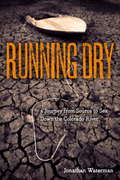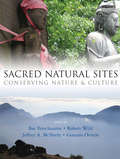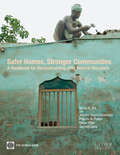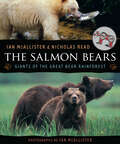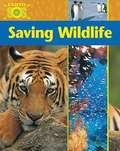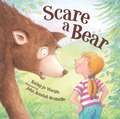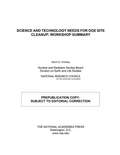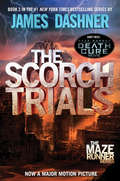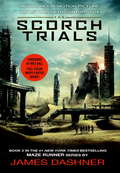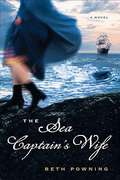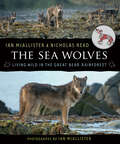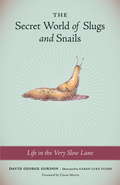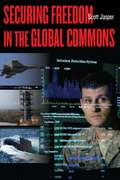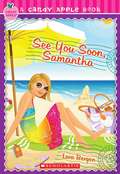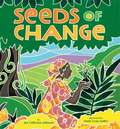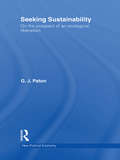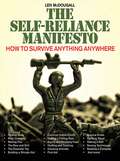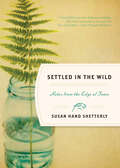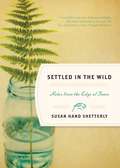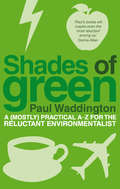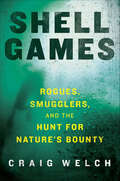- Table View
- List View
Running Dry: A Journey From Source to Sea Down the Dying Colorado River
by Jonathan WatermanDammed and tunneled, forced into countless canals, trapped in reservoirs and harnessed for electricity, what once was untamed and free is now humbled, parched, and so yoked to human purposes that in most years it trickles away 100 miles from its oceanic destination. Waterman writes with informal immediacy in this eye-witness account of the many demands on the Colorado, from irrigating 3.5 million acres of farmland to watering the lawns of Los Angeles. He shows how our profligacy and inexorable climate change spark political conflict, and how we can avert this onrushing ecological crisis. As he follows Powell afloat and afoot, Waterman reaches out both to adventure travelers and to scientists, conservationists, environmentalists, and anyone interested in the fragile interplay between nature and humans.
Running Dry
by Jonathan WatermanIn 1869, John Wesley Powell led a small party down the Green and Colorado Rivers in a bold attempt to explore the Grand Canyon for the first time. After their monumental expedition, they told of raging rapids, constant danger, and breathtaking natural beauty of the American landscape at its most pristine.Jon Waterman combines sheer adventure and environmental calamity in this trailblazing cautionary account of his 2008 trip down the overtaxed, drying Colorado. Dammed and tunneled, forced into countless canals, trapped in reservoirs and harnessed for electricity, what once was untamed and free is now humbled, parched, and so yoked to human purposes that in most years it trickles away 100 miles from its oceanic destination.Waterman writes with informal immediacy in this eye-witness account of the many demands on the Colorado, from irrigating 3.5 million acres of farmland to watering the lawns of Los Angeles. He shows how our profligacy and inexorable climate change spark political conflict, and how we can avert this onrushing ecological crisis. As he follows Powell afloat and afoot, Waterman reaches out both to adventure travelers and to scientists, conservationists, environmentalists, and anyone interested in the fragile interplay between nature and humans.
Sacred Natural Sites: Conserving Nature and Culture
by Bas Verschuuren Robert Wild Jeffrey McNeely Gonzalo OviedoSacred Natural Sites are the world's oldest protected places. This book focuses on a wide spread of both iconic and lesser known examples such as sacred groves of the Western Ghats (India), Sagarmatha /Chomolongma (Mt Everest, Nepal, Tibet - and China), the Golden Mountains of Altai (Russia), Holy Island of Lindisfarne (UK) and the sacred lakes of the Niger Delta (Nigeria). The book illustrates that sacred natural sites, although often under threat, exist within and outside formally recognised protected areas, heritage sites. Sacred natural sites may well be some of the last strongholds for building resilient networks of connected landscapes. They also form important nodes for maintaining a dynamic socio-cultural fabric in the face of global change. The diverse authors bridge the gap between approaches to the conservation of cultural and biological diversity by taking into account cultural and spiritual values together with the socio-economic interests of the custodian communities and other relevant stakeholders.
Safer Homes, Stronger Communities: A Handbook for Reconstructing After Natural Disasters
by Priscilla M. Phelps Daniel Pittet Stephen Sena Jennifer Duyne Barenstein Abhas K. JhaBest practices in post-disaster housing and community reconstruction are constantly evolving. The frequency and severity of disasters are increasing and technology is changing how reconstruction is done. Reconstruction projects must increasingly focus on the need to reduce future risks by ensuring that what is rebuilt is safer and more disaster-resilient than what was there before. The expanding role of communities in managing community reconstruction, with financial and technical assistance from government, is another way reconstruction is changing. 'Safer Homes, Stronger Communities' is a handbook that gives policy makers and project managers the information they need to plan and carry out housing and community reconstruction projects that empower communities affected by disasters and that reduce their vulnerability to future disasters. The handbook includes nearly 100 case studies collected from global experts with recent experience in housing reconstruction that illustrate how the policies and practical approaches recommended in the handbook have been used on the ground. It also includes links to extensive technical information on the topics covered by the handbook and is complemented by a Web site for practitioners in the field (http://www.housingreconstruction.org). Designed to provide immediate guidance in post-disaster reconstruction settings, 'Safer Homes, Stronger Communities' is a vital resource for policy makers and project managers, and for all practitioners involved in post-disaster housing and community reconstruction and disaster risk management.
The Salmon Bears: Giants of the Great Bear Rainforest
by Nicholas ReadExtensively illustrated with Ian McAllister's magnificent photographs, The Salmon Bears explores the delicate balance that exists between the grizzly, black and spirit bears and their natural environment, the last great wilderness along the central coast of British Columbia. Key to this relationship are the salmon that are born in the rivers each spring, who then go out to sea as juveniles and return as adults to spawn and die, completing a cycle of life that ensures the survival of not only their own species but also virtually every other plant and animal in the rainforest. In clear language suitable for young readers, the authors describe the day-to-day activities that define the lives of these bears through the four seasons. But this is also very much the story of the Great Bear Rainforest—a vast tract of land that stretches from the northern tip of Vancouver Island to the Alaska border and contains some of the largest stands of old-growth forest left on the West Coast. The Salmon Bears focuses on the interconnectedness of all life in the rainforest and makes a strong case for the importance of protecting this vital ecological resource.
Saving Wildlife (Earth SOS)
by Sally MorganOffering information at multiple levels for several reading levels, this series describes the many dimensions of wildlife depletion and its related problems that accompany global warming and mankind's abuse of the environment. The interdependence of all the natural systems in the world are stressed in the book. This volume concludes with a fact file and suggestions for the reader on how to improve the environment.
Scare a Bear
by Kathy-Jo WarginScare a Bear. Do you know how to scare a bear? Would you bang pots and pans? Would you rattle some cans? Would you shout? Would you yell? Would you ring a loud bell? Do you know how to scare a bear? How would you scare a bear out of your cabin? Or out of your fishing boat? How about away from your campfire? And what if he climbed in your bunk? Would the bed go kerplunk? From the author-illustrator team who created Moose on the Loose comes yet another example of the high jinks and hilarity that happens when wildlife wanders indoors. In this contest of wills, who will win? And once again, by story's end, young campers will know exactly how to scare a bear!
Science and Risk Regulation in International Law
by Jacqueline PeelThe regulation of risk is a preoccupation of contemporary global society and an increasingly important part of international law in areas ranging from environmental protection to international trade. This book examines a key aspect of international risk regulation - the way in which science and technical expertise are used in reaching decisions about how to assess and manage global risks. An interdisciplinary analysis is employed to illuminate how science has been used in international legal processes and global institutions such as the World Trade Organization. Case studies of risk regulation in international law are drawn from diverse fields including environmental treaty law, international trade law, food safety regulation and standard-setting, biosafety and chemicals regulation. The book also addresses the important question of the most appropriate balance between science and non-scientific inputs in different areas of international risk regulation.
Science and Technology for DOE Site Cleanup: Workshop Summary
by National Research Council of the National AcademiesThe Department of Energy's Office of Environmental Management is developing a technology roadmap to guide planning and possible future congressional appropriations for its technology development programs. It asked the National Research Council of the National Academies to provide technical and strategic advice to support the development and implementation of this roadmap, specifically by undertaking a study that identifies principal science and technology gaps and their priorities for the cleanup program based on previous National Academies reports, updated and extended to reflect current site conditions and EM priorities and input form key external groups, such as the Nuclear Regulatory Commission, Defense Nuclear Facilities Safety Board, Environmental Protection Agency, and state regulatory agencies. In response, this book provides a high-level synthesis of principal science and technology gaps identified in previous NRC reports in part 1. Part 2 summarizes a workshop meant to bring together the key external groups to discuss current site conditions and science and technology needs.
The Scorch Trials (The Maze Runner #2)
by James DashnerSolving the Maze was supposed to be the end. No more puzzles. No more variables. And no more running. Thomas was sure that escape meant he and the Gladers would get their lives back. But no one really knew what sort of life they were going back to. In the Maze, life was easy. They had food, and shelter, and safety . . . until Teresa triggered the end. In the world outside the Maze, however, the end was triggered long ago. Burned by sun flares and baked by a new, brutal climate, the earth is a wasteland. Government has disintegrated--and with it, order--and now Cranks, people covered in festering wounds and driven to murderous insanity by the infectious disease known as the Flare, roam the crumbling cities hunting for their next victim . . . and meal. The Gladers are far from finished with running. Instead of freedom, they find themselves faced with another trial. They must cross the Scorch, the most burned-out section of the world, and arrive at a safe haven in two weeks. And WICKED has made sure to adjust the variables and stack the odds against them. Thomas can only wonder--does he hold the secret of freedom somewhere in his mind? Or will he forever be at the mercy of WICKED?
The Scorch Trials (The Maze Runner #2)
by James DashnerRead the second book in the #1 New York Times bestselling Maze Runner series that is soon to be a motion picture, hitting theaters September 18, 2015, and is perfect for fans of The Hunger Games and Divergent. This special movie tie-in edition features an eight-page full-color insert with photos from the film. The first book, The Maze Runner, is now a movie featuring the star of MTV's Teen Wolf, Dylan O'Brien; Kaya Scodelario; Aml Ameen; Will Poulter; and Thomas Brodie-Sangster! Also look for James Dashner's newest series: the Mortality Doctrine that includes The Eye of Minds and The Rule of Thoughts.Solving the Maze was supposed to be the end.Thomas was sure that escape from the Maze would mean freedom for him and the Gladers. But WICKED isn't done yet. Phase Two has just begun. The Scorch.There are no rules. There is no help. You either make it or you die.The Gladers have two weeks to cross through the Scorch--the most burned-out section of the world. And WICKED has made sure to adjust the variables and stack the odds against them.Friendships will be tested. Loyalties will be broken. All bets are off.There are others now. Their survival depends on the Gladers' destruction--and they're determined to survive.Praise for the Maze Runner series:A #1 New York Times Bestselling SeriesA USA Today BestsellerA Book Sense BestsellerAn Indie Next List SelectionA Kirkus Reviews Best Teen Book of the YearAn ALA-YASLA Best Fiction for Young Adults BookAn ALA-YALSA Quick Pick"[A] mysterious survival saga that passionate fans describe as a fusion of Lord of the Flies, The Hunger Games, and Lost."-EW.com"Wonderful action writing--fast-paced...but smart and well observed."-Newsday"[A] nail-biting must-read."-Seventeen.com"Breathless, cinematic action."-Publishers Weekly"Heart-pounding to the very last moment."-Kirkus Reviews"Exclamation-worthy."-Romantic Times[STAR] "James Dashner's illuminating prequel [The Kill Order] will thrill fans of this Maze Runner [series] and prove just as exciting for readers new to the series."-Shelf Awareness, Starred
The Sea Captain's Wife
by Beth PowningAzuba Galloway, daughter of a shipwright, sees ships leaving for foreign ports from her bustling town on the Bay of Fundy and dreams of seeing the world. When she marries Nathaniel Bradstock, a veteran sea captain, she believes she will sail at his side. But when she becomes pregnant she is forced to stay behind. Her father has built the couple a gabled house overlooking the bay, but the gift cannot shelter her from the loneliness of living without her husband. When Azuba becomes embroiled in scandal, Nathaniel is forced to take her and their daughter, Carrie, aboard his ship. They set sail for London with bitter hearts. Their voyage is ill-fated, beset with ferocious storms and unforeseen obstacles that test Azuba's compassion, courage and love. Alone in a male world, surrounded by the splendour and the terror of the open seas, she must face her fears and fight to keep her family together.
The Sea Wolves: Living Wild in the Great Bear Rainforest
by Nicholas ReadThe Sea Wolves sets out to disprove the notion of "the Big Bad Wolf," especially as it is applied to coastal wolves—a unique strain of wolf that lives in the rainforest along the Pacific coast of Canada. Genetically distinct from their inland cousins and from wolves in any other part of the world, coastal wolves can swim like otters and fish like the bears with whom they share the rainforest. Smaller than the gray wolves that live on the other side of the Coast Mountains, these wolves are highly social and fiercely intelligent creatures. Living in the isolated wilderness of the Great Bear Rainforest, coastal wolves have also enjoyed a unique relationship with man. The First Nations people, who have shared their territory for thousands of years, do not see them as a nuisance species but instead have long offered the wolf a place of respect and admiration within their culture. Illustrated with almost one hundred of Ian McAllister's magnificent photographs, The Sea Wolves presents a strong case for the importance of preserving the Great Bear Rainforest for the wolves, the bears and the other unique creatures that live there.
The Secret World of Slugs and Snails
by David George GordonA preeminent expert on the small wonders of the natural world, David George Gordon playfully and thoughtfully sheds light on the fascinating lives of slugs and snails. Covering everything from snail sex to the manufacture of synthetic slug slime, Gordon takes us on a journey through the languid and magical world of these charismatic invertebrates. From essays like Grow Your Own Escargot to indispensable gardening tips, this book is chock-full of information on the much-maligned mollusks. Whether removing non-native slugs from your garden or following a native snail as it meanders across the forest floor, you'll never look at these underdogs the same way again. David George Gordon is the author of nineteen books about the natural world, including the best-selling Eat-a-Bug Cookbook and The Compleat Cockroach. Karen Luke Fildes is an accomplished artist who has studied at both the Art Institute of Seattle and Chapman University. Both live in Seattle.
Securing Freedom in the Global Commons
by Scott JasperThe new millennium has brought with it an ever-expanding range of threats to global security: from cyber attacks to blue-water piracy to provocative missile tests. Now, more than ever then, national security and prosperity depend on the safekeeping of a global system of mutually supporting networks of commerce, communication, and governance. The global commons-outer space, international waters, international airspace, and cyberspace-are assets outside of national jurisdiction that serve as essential conduits for these networks, facilitating the free flow of trade, finance, information, people, and technology. These commons also comprise much of the international security environment, enabling the physical and virtual movement and operations of allied forces. Securing freedom of use of the global commons is therefore fundamental to safeguarding the global system. Unfortunately, the fact that civil and military operations in the commons are inherently interwoven and technically interdependent makes them susceptible to intrusion. This intrinsic vulnerability confronts the international defense community with profound challenges in preserving access to the commons while countering elemental and systemic threats to the international order from both state and non-state actors. In response, the authors of this volume-a team of distinguished academics and international security practitioners-describe the military-operational requirements for securing freedom of action in the commons. Collaborating from diverse perspectives, they examine initiatives and offer frameworks that are designed to minimize vulnerabilities and preserve advantages, while recognizing that global security must be underscored by international cooperation and agreements. The book is written for security professionals, policy makers, policy analysts, military officers in professional military education programs, students of security studies and international relations, and anyone wishing to understand the challenges we face to our use of the global commons.
Security and the Environment
by Rita FloydIn 1993 the first Clinton administration declared environmental security a national security issue, but by the end of the Bush administrations environmental security had vanished from the government's agenda. This book uses changing US environmental security policy to propose a revised securitisation theory, one that both allows insights into the intentions of key actors and enables moral evaluations in the environmental sector of security. Security and the Environment brings together the subject of environmental security and the Copenhagen School's securitisation theory. Drawing on original interviews with former key players in United States environmental security, Rita Floyd makes a significant and original contribution to environmental security studies and security studies more generally. This book will be of interest to international relations scholars and political practitioners concerned with security, as well as students of international environmental politics and US policy-making.
See You Soon, Samantha
by Lara BergenFollow best friends Liza, Samantha, and Mina as they spend their first summer apart--and try to find the perfect souvenirs for one another. Without her friends, Samantha feels lost at the beach, but maybe that's where she'll find herself.
Seeds of Change: Planting a Path to Peace
by Jen Cullerton JohnsonA biography of scientist Wangari Maathai, the first African woman - and first environmentalist - to win a Nobel Peace Prize in 2004 for planting trees in her native Kenya.
Seeking Sustainability: On the prospect of an ecological liberalism (New Political Economy Ser. #17)
by G. J PatonThe ideas of neoliberalism perpetuate a disembedded and dichotomised view of economy-ecology relations. The renewed interest in climate change and sustainability attests to the lack of progress achieved by the ‘sustainable development’ regime and to the need for more appropriate frameworks for guiding social organisation toward ecological sustainability. This book is born of the need for a critique of current approaches to environmental policy and governance and the search for alternative sustainability frameworks. Utilising a conceptual approach based on the Polanyian concept of ‘embeddedness’, this book argues that the links between economic theory, neo-liberalism, and the current regime of sustainable development, have rendered ‘sustainability’ a discursive frame in the service of economic rather than ecological goals. In rejecting the integrity of ‘environmental neo-liberalism’, Paton argues there are some clear points of divergence between liberalism and neo-liberalism. She subsequently examines separately the impact on liberalism of efforts to integrate environmental concerns in order to determine if therein lies the potential for an effective reformist politics of ‘ecological sustainability’.
The Self-Reliance Manifesto: Essential Outdoor Survival Skills
by Len McdougallStorm approaching? Need a fire? Out of water? Lost? Whatever situation you find yourself in, Len McDougall has probably been there himself and can get you out of trouble. He reveals his way of living and teaches readers how to have the same confidence in any scenario. In this comprehensive, fully-illustrated guide, McDougall reveals how to make water safe for drinking, build a fire in any conditions, find and build shelter, use basic medical skills, and more. McDougall has field-tested everything from kayaks, backpacks, and boots to cameras, tents, and water filters, and because of his research and experience, everyone can feel more safe.
Settled in the Wild: Notes from the Edge of Town
by Susan Hand ShetterlyWhether we live in cities, suburbs, or villages, we are encroaching on nature, and it in one way or another perseveres. Naturalist Susan Shetterly looks at how animals, humans, and plants share the land—observing her own neighborhood in rural Maine. She tells tales of the locals (humans, yes, but also snowshoe hares, raccoons, bobcats, turtles, salmon, ravens, hummingbirds, cormorants, sandpipers, and spring peepers). She expertly shows us how they all make their way in an ever-changing habitat. In writing about a displaced garter snake, witnessing the paving of a beloved dirt road, trapping a cricket with her young son, rescuing a fledgling raven, or the town's joy at the return of the alewife migration, Shetterly issues warnings even as she pays tribute to the resilience that abounds. Like the works of Annie Dillard and Aldo Leopold, Settled in the Wild takes a magnifying glass to the wildness that surrounds us. With keen perception and wit, Shetterly offers us an education in nature, one that should inspire us to preserve it.
Settled in the Wild: Notes from the Edge of Town
by Susan Hand ShetterlyWhether we live in cities, suburbs, or villages, we are encroaching on nature, and it in one way or another perseveres. Naturalist Susan Shetterly looks at how animals, humans, and plants share the land-observing her own neighborhood in rural Maine. She tells tales of the locals (humans, yes, but also snowshoe hares, raccoons, bobcats, turtles, salmon, ravens, hummingbirds, cormorants, sandpipers, and spring peepers). She expertly shows us how they all make their way in an ever-changing habitat. In writing about a displaced garter snake, witnessing the paving of a beloved dirt road, trapping a cricket with her young son, rescuing a fledgling raven, or the town's joy at the return of the alewife migration, Shetterly issues warnings even as she pays tribute to the resilience that abounds. Like the works of Annie Dillard and Aldo Leopold, Settled in the Wild takes a magnifying glass to the wildness that surrounds us. With keen perception and wit, Shetterly offers us an education in nature, one that should inspire us to preserve it.
Shades Of Green: A (mostly) practical A-Z for the reluctant environmentalist
by Paul WaddingtonFew of us have what it takes to go 'all the way' on the green scale. Yet as fears about the food chain, climate change, plummeting biodiversity and the sustainability of our current lifestyles take hold, wouldn't it be good to be clear about our range of options?Whether you are pondering bicycles or baths, holidays or heating, pets or pasta, washing dishes or wine, Shades of Green is the book for you. It's an easy-to-use, A-Z guide which sets out your choices on a scale from 'completely green' to 'not even a little bit green'. No preaching. No finger-wagging.Whether you're an eco-warrior or a planet-trasher or, like most of us, something in between, Shades of Green will give you all you need to know so you can choose what suits you best. This is essential and often surprising reading.
Shell Games: Rogues, Smugglers, and the Hunt for Nature's Bounty
by Craig WelchShell Games is a cops-and-robbers tale set in a double-crossing world where smugglers fight turf wars over some of the world's strangest marine creatures.Puget Sound sits south of the border between the U.S. and Canada and is home to the magnificent geoduck (pronounced "gooey duck"), the world's largest burrowing clam. Comically proportioned but increasingly fashionable as seafood, the geoduck has been the subject of pranks, TV specials, and gourmet feasts. But this shellfish is so valuable it is also traded for millions of dollars on the black market— a world where outlaw scuba divers dodge cops while using souped-up boats, night-vision goggles, and weighted belts to pluck the succulent treasures from the sea floor. And the greatest dangers come from rival poachers who resort to arson and hit men to eliminate competition and stake their claim in the geoduck market. Detective Ed Volz spent his life chasing elk-antler thieves, bobcat smugglers, and eagle talon poachers. Now he was determined to find the kingpin of the geoduck underworld. He and a team of federal agents set up illegal sales, secretly recorded conversations, and photographed hand-offs from the bushes. For years, they tracked a rogues' gallery of lawbreakers, who eventually led them to the biggest thief of all— a darkly charming con man who called himself the "GeoduckGotti" and who worked both sides of the law.In Shell Games, veteran environmental journalist Craig Welch delves into the wilds of our nation's waters and forests in search of some of America's most unusual criminals and the cops who are on a mission to take them down. This thrilling examination of the international black market for wildlife is filled with butterfly thieves, bear slayers, and shark-trafficking pastors— all part of one of the largest illegal trades in the world.
